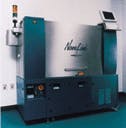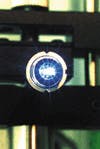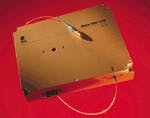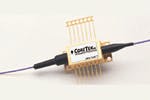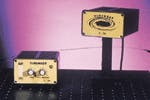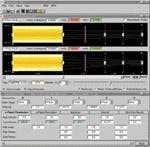Commercial Technology Achievement Awards: Judges name 2000 CTA Award winners
W. Conard HoltonExecutive Editor
Here on these pages are the products chosen by our judgesmembers of our Editorial Advisory Boardto receive the 2000 Laser Focus World Commercial Technology Achievement Awards. In this, the eleventh year, competition was as stiff as ever. Congratulations to the eight winners! They will receive their awards in a special ceremony at Photonics West '00 later this month in San Jose, CA. The 32 products that were finalists are also worthy of note (see box below). Entries for next year's competition are due by September 15, 2000; contact assistant editor Carole Root for details (tel: 603-891-9138; e-mail: [email protected]).
NONDIODE LASERS
The NovaLine F600 fluoride (F2) laser series for lithography was first commercialized by Lambda Physik (Ft. Lauderdale, FL) in May 1999. The F600 is a 600-Hz pulsed laser that is available in either broadband or line-selected models. In addition to its role in materials testing and feasibility studies for 157-nm optical lithography, this laser is an enabling technology for developing small-field and mini-scanner systems. The unique resonator design maximizes optical system performance and allows single-line operation at 157.6299 nm with a bandwidth of <1.5 µm, while delivering 10 mJ/pulse and 6 W of output power. The F600 demonstrates stable operation up to 1 kHz and high yield efficiency and durability even at 157 nm. A laboratory demonstration of 2 kHz (20 W) reflects the potential of the series.
DIODE LASERS
The first pulsed operation of blue (violet) indium gallium nitride (InGaN) laser diodes was demonstrated by Nichia (Anan, Japan) in 1995. In February 1999, the company began shipping commercial samples of this long-awaited device, which has since been incorporated into modules by other companies. The Model NLHV500E laser diode has an output power of approximately 5 mW, an emission wavelength of 400-420 nm, an operating current of 40 mA, and an operating voltage of 5 V. Short-wavelength semiconductor lasers have been sought for applications such as spectroscopy, full-color electroluminescent displays, laser printers, undersea optical communications, and optical storage. In optical storage, InGaN lasers would allow sharper focusing and increased storage density and could raise the capacity of DVD from the current disk size limit of approximately 4.7 Gbits to 20 Gbits.
OPTICS/OPTICAL MATERIALS
Distributed Raman amplification offers the opportunity to increase transmission distances by taking advantage of the transmission fiber itself to provide additional gain. The SDL-RL30-1455 Raman fiber laser, developed by SDL (San Jose, CA) and introduced in February 1999, offers this advantage to dense wavelength-division-multiplexing systems. It also offers the advantage that it can be used over a wide wavelength range rather than the fixed wavelength region of the standard optical amplifier. The RL-30 pump system consists of a double-clad fiber laser pumped by an array of laser diodes, followed by a Raman wavelength shifter that provides successive shifts to the emission wavelength. The fiber laser was introduced with both 1455- and 1480-nm wavelengths available. The 1.5 W of output power can be scaled to lower power to enable better overall system reliability.
FIBEROPTICS/OPTOELECTRONIC COMPONENTS
CoreTek (Wilmington, MA) introduced its MEM-TUNE tunable filter in June 1999, demonstrating the value of microelectromechanical technology in applications that require rapid tuning over a wide wavelength range. The filter is reliable, having been tested by cycling through the equivalent of almost 800 years of operation in a typical systems application. Its compact size enables integration into optical fiber amplifiers as well as hand-held devices for field channel-monitoring applications. MEM-TUNE is suitable for applications that require continuous and rapid tuning such asin the case of the 20-pm linewidth filterchannel monitoring in dense wavelength-division-multiplexing systems where channel wavelengths, power levels, and signal-to-noise ratios are constantly monitored to ensure signal integrity. The 50- and 100-pm filters are best suited for optical add/drop multiplexer and cross-connect applications.
DETECTORS
The Blue Plus Image Sensor family was introduced by Eastman Kodak (Rochester, NY) in January 1999. These front-illuminated, full-frame charge-coupled devices (CCD) use a new, transparent gate-electrode material and fabrication process that allows more light to each pixel and thus boosts overall responsivity without an increase in noise. At 400 nm, the quantum efficiency improves from 2% to 30%; in addition, the region between 300 and 400 nm is opened. These advances provide significant benefits to astronomers, biomedical researchers, and spectroscopists. Mammography and dental images can be acquired with less x-ray exposure. The family of sensors ranges in size from 512 x 512 up to 3088 x 2056 resolution and from 6.8- to 24-µm-square pixels. The mechanical form-factor and electrical pin-out is the same as existing Kodak full-frame image sensors.
IMAGING SYSTEMS/VISION SYSTEMS
The HSFC-PRO Ultra Fast Framing Camera from The Cooke Corporation (Auburn Hills, MI) captures up to eight high-resolution images with an exposure time as short as 1.5 ns. Introduced in October 1998, the HSFC allows researchers to image ultrafast phenomena such as hypervelocity impact testing of space debris colliding with satellites and other objects. Light sources such as pulsed lasers can be synchronized with the camera to image the dynamics of ballistics and hypervelocity flows. In addition, images of ultrasonic flame propagation, laser ablation, and sparks can be captured. Light is imaged with a standard lens input, then channeled to four 1280 x 1280 intensified CCD modules with 12 bits of dynamic range, digitized, and displayed on a monitor. The result is high-resolution and high-contrast digital images.
INSTRUMENTATION
Elliot Scientific (Harpenden, Hertfordshire, England) released its Timewarp E-750 autocorrelator in November 1998 to measure the duration of pulses from modelocked femtosecond lasers. The autocorrelator is compact, portable, inexpensive, simple to set up and align, insensitive to input polarization, and broadband in response (700-1250 nm). It consists of an optical head and a control unit plus external power supply. The Timewarp will handle pulse lengths between 15 and 500 fs by incorporating an LED to achieve the same functionality as a frequency-doubling crystal and photomultiplier tube. This feat is accomplished by recombining a split pulse train on a GaAsP LED, where two-photon absorption occurs and the autocorrelation appears as an electrical signal. Two units can be operated as master/slave, enabling the pulsewidth to be measured at two locations on the same laser system.
ACCESSORIES
Simulation software for optimizing laser design is rare, but Micro Systems Design (Munich, Germany) produced a package to rigorously analyze the complex interactions of thermal and optical effects in solid-state laser resonators. LASCAD 2.0 was introduced in May 1999 to provide the finite-element analysis necessary to compute temperature distribution, deformation, and stress or fracture mechanics in laser crystals. LASCAD can also run a Gaussian ABCD algorithm to carry through fast analysis of thermal effects on mode formation and run a wave optics code when the algorithm is not sufficient. The graphical user interface of the program can function as an optical workbench on the PC and permit intuitive design of laser resonators. These tools provide engineers with a better understanding of the system as it is characterized.
Finalists for 2000
Alcatel Optronics (2) 1905 LMI 20-mW L-band ultradense WDM system; 1998 SMG high-reliability 980-nm pump laser module for submarine application...Atto Instruments CARV confocal optical module and CARVer software...Breault Research Organization Reflector CAD...BTI Fiber Optic Engineering BT-1000 wavelength meter...Burleigh Instruments WA-7000 Multi-Line Wavemeter optical channel analyzer...Coherent Laser Group Verdi V10 laser...Cordin Company Model 220-8 gated, intensified ultrahigh-speed CCD camera...Crystal Associates periodically poled RTA...EG&G Optoelectronics channel photomultiplier...Fiber Instrument Sales FIS local-area network design software...Honeywell Sensing and Control SMV2637 VCSEL...Imaging Technology SmART Search machine-vision software...INO optical correlator...IPG Photonics ManyChannel DWDM erbium-doped fiber amplifier... Jenoptik Laserdiode JOLD-2000-CAXF-25P2W2...LightPath Technologies 600-µm beam diameter collimator...Lytron Kodiak recirculating chiller...New Focus (2) Model 6428 telecom-test laser; Model PO803 3-port optical circulators . . .Ofil Ltd. DayCor bispectral camera-corona detector...Omega Optical ALPHA filter series...Optiwave EDFA-Design optical fiber amplifier and laser design software...Photonics Industries 5-W UV diode-pumped solid-state Nd:YAG laser...PicoQuant GmbH PDL 800-B with LDH 400 violet picosecond diode laser...Polytec PI DL100-UV single-mode tunable blue diode laser...Richter Enterprises/Optec srl multispectral prism module...Roper Scientific Princeton Instruments PI-MAX intensified camera...Sensors Unlimited Su320-SMC NIR area camera...Spectra-Physics Lasers (2) Mai Tai laser; Millennia Xs laser...Stanford Computer Optics 4 Picos intensified camera.

